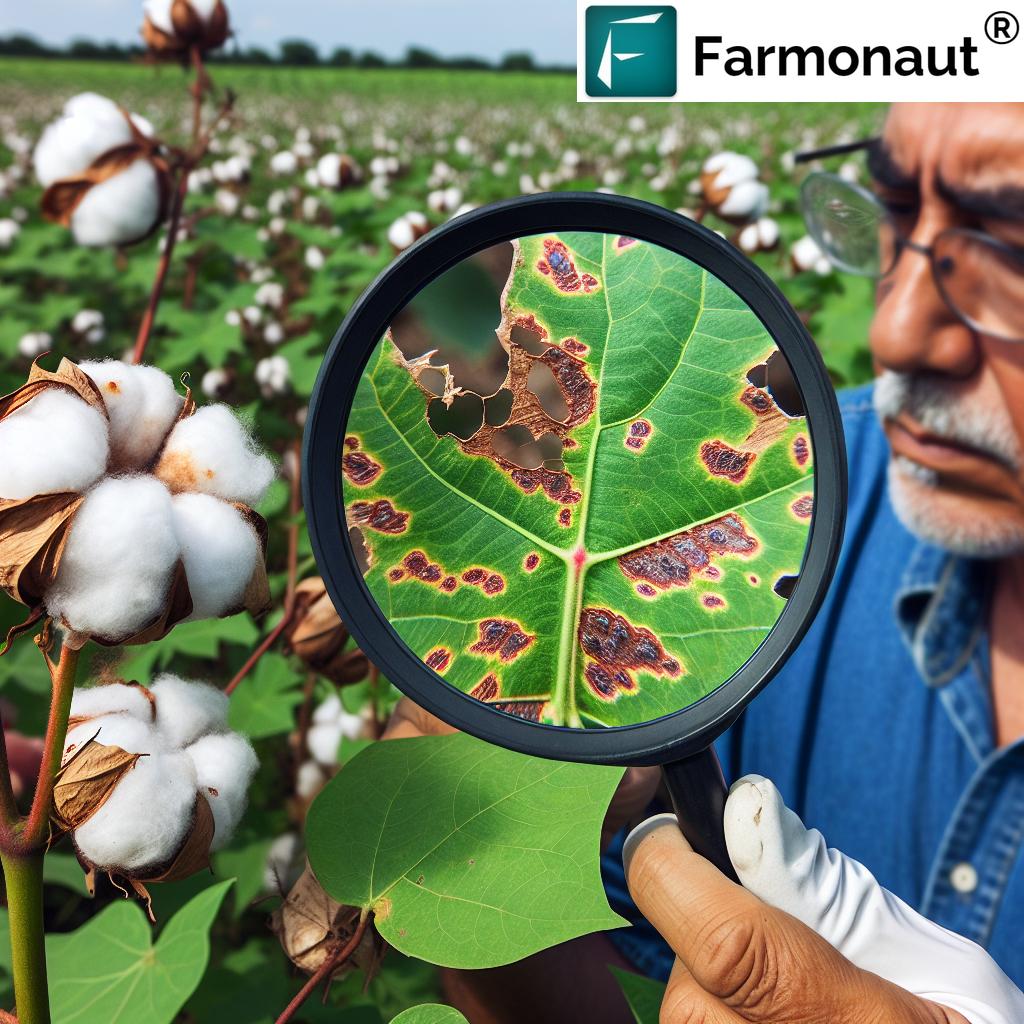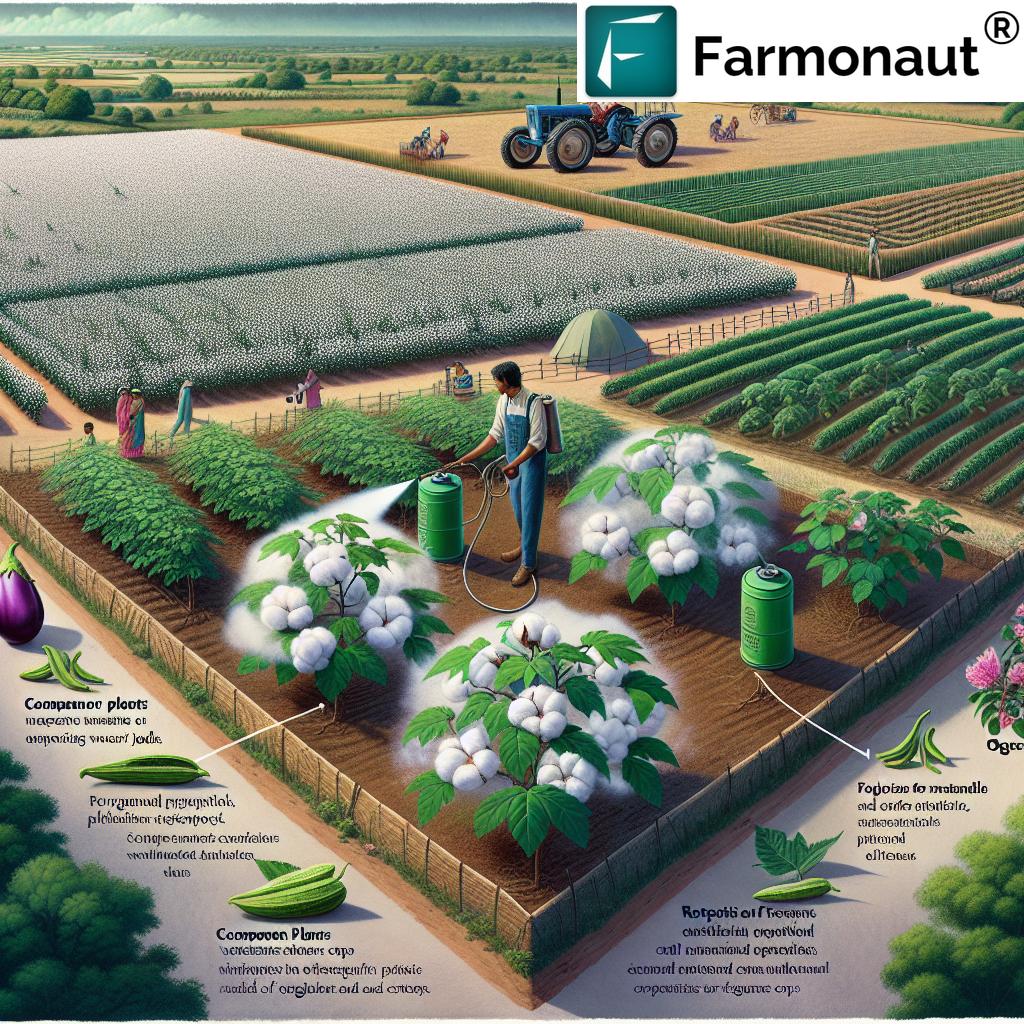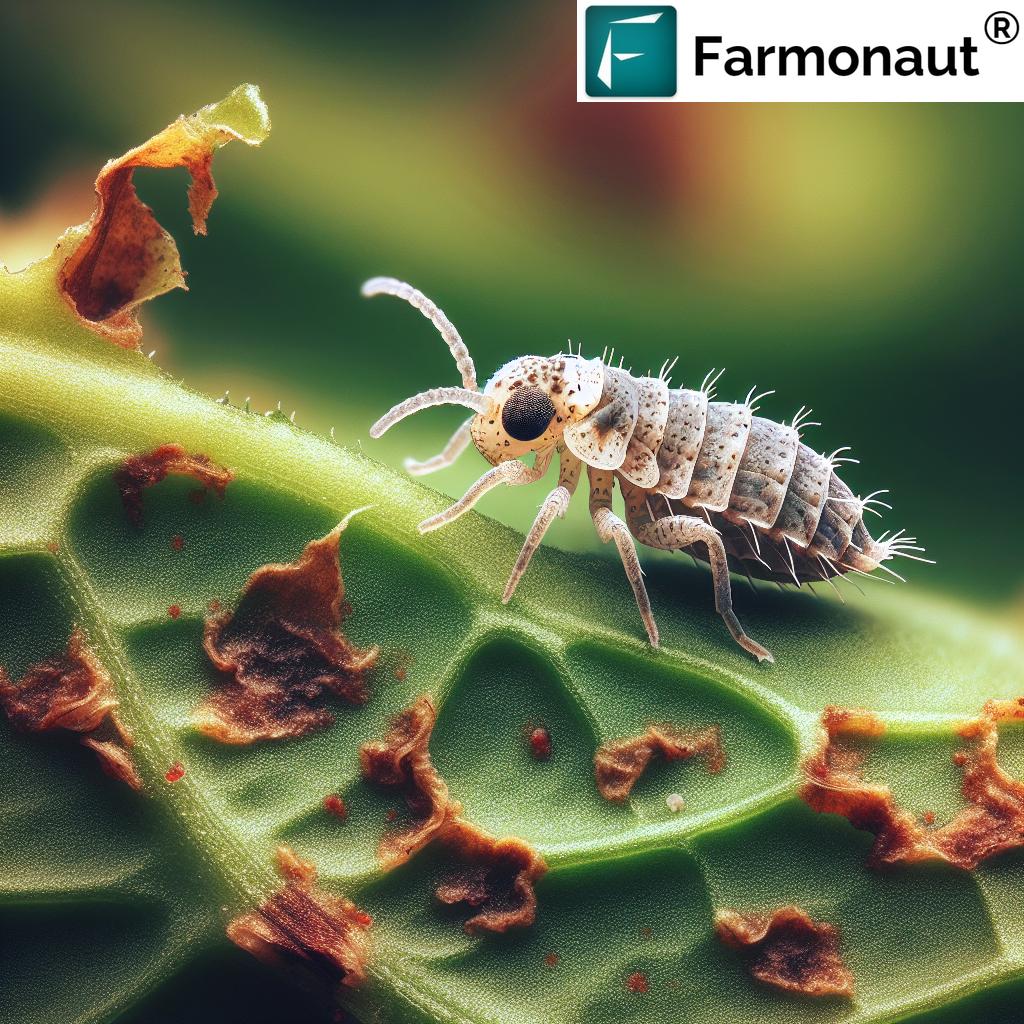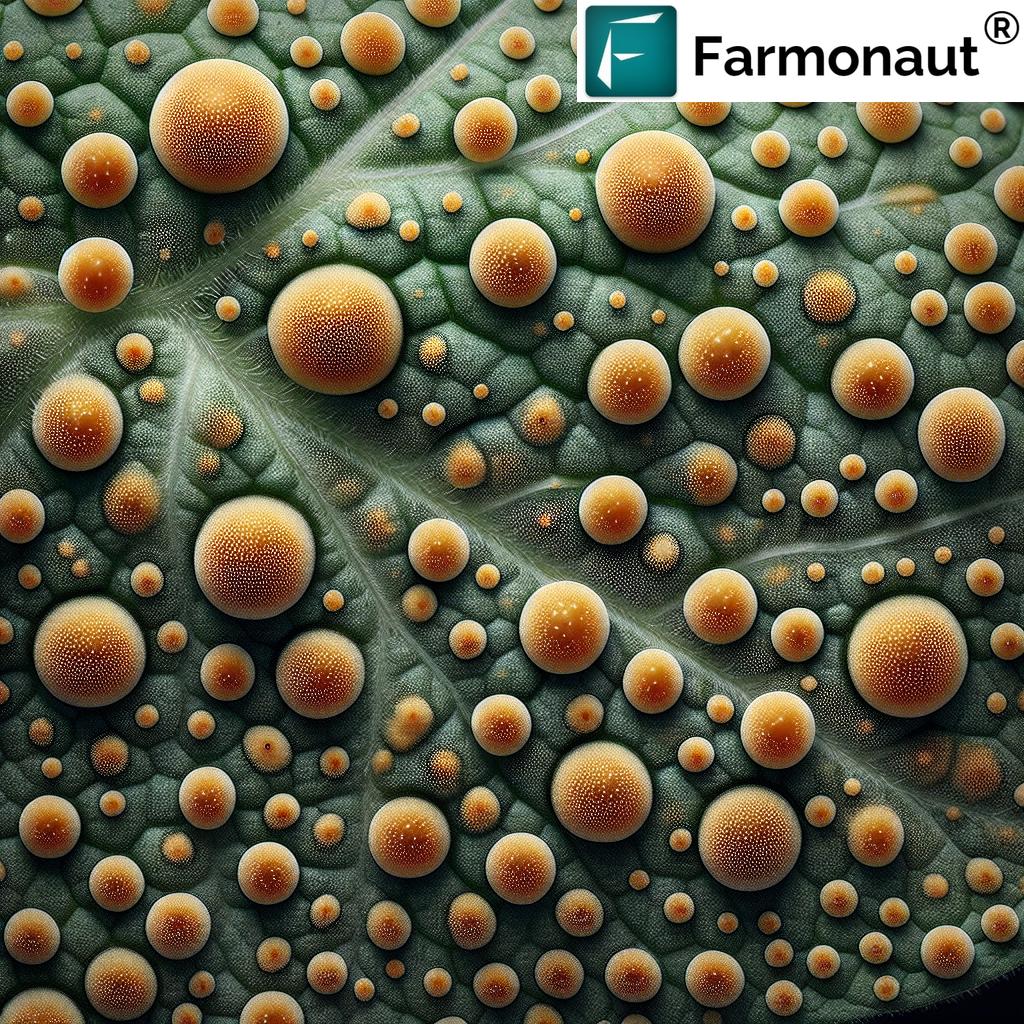Ultimate Guide: Mastering Cotton Jassid Control for Healthy Crops and Sustainable Farming
“Cotton jassids can reduce crop yields by up to 50% if left uncontrolled, highlighting the importance of effective pest management.”
Welcome to our comprehensive guide on mastering cotton jassid control for healthy crops and sustainable farming practices. As experts in agricultural technology and pest management, we at Farmonaut understand the critical importance of effective cotton pest management in ensuring bountiful harvests and maintaining the long-term viability of cotton farming. In this guide, we’ll delve deep into the world of cotton jassids, exploring their impact on crops, identification techniques, and most importantly, the various strategies for jassid control in agriculture.
Cotton, or “algodón” as it’s known in Spanish-speaking regions, is a vital crop for many farmers worldwide. However, the persistent threat of pests, particularly the cotton jassid (Amrasca devastans), poses significant challenges to cotton plant health and overall yield. These small but destructive insects can wreak havoc on cotton fields, affecting not only the quantity but also the quality of the harvest.
Understanding Cotton Jassids: The Green Menace
Cotton jassids, belonging to the Cicadellidae family, are small, green, wedge-shaped insects that pose a significant threat to cotton crops. These pests, scientifically known as Amrasca devastans, are not limited to cotton alone; they also infest other plants such as eggplant, potato, pepper, okra, and soy. Let’s explore the key characteristics of these destructive pests:
- Appearance: Adult jassids are typically 2-3 mm long, with a distinctive green color that helps them blend in with the leaves of host plants.
- Behavior: They are known for their jumping ability, quickly hopping from leaf to leaf when disturbed.
- Life Cycle: Jassids undergo incomplete metamorphosis, with eggs, nymphs, and adults all potentially present in a field simultaneously.
- Feeding Habits: Both nymphs and adults feed by sucking sap from the underside of leaves, causing significant damage to the plant.
Understanding these characteristics is crucial for effective cotton pest identification and implementing targeted control measures.
The Impact of Jassid Infestation on Cotton Crops
The damage caused by cotton jassids can be severe and far-reaching. Here are some of the primary ways jassid infestations affect cotton plants:
- Stunted Growth: Jassid feeding inhibits plant growth, resulting in smaller, less productive cotton plants.
- Leaf Damage: Infested leaves often curl upwards and develop a reddish tinge, a condition known as “hopper burn.”
- Reduced Photosynthesis: Damaged leaves are less efficient at photosynthesis, impacting overall plant health and productivity.
- Yield Loss: Severe infestations can lead to significant reductions in cotton yield, sometimes up to 50% if left unchecked.
- Quality Degradation: The fiber quality of cotton can be compromised, affecting its market value.
Given these impacts, it’s clear why effective jassid control in agriculture is crucial for sustainable cotton farming.
Identifying Jassid Infestations: Early Warning Signs
Early detection is key to successful pest management. Here are the symptoms to watch for when monitoring your cotton fields:
- Leaf Discoloration: Look for leaves turning pale green, yellow, or reddish-brown, especially at the edges.
- Leaf Curling: Infested leaves often curl upwards and may appear crinkled.
- Visible Pests: Adult jassids and nymphs can be seen on the underside of leaves, especially in the early morning or late afternoon.
- Stunted Plants: Compare plant heights across your field; jassid-infested plants may be noticeably shorter.
- Reduced Vigor: Infested plants generally appear less healthy and vigorous compared to unaffected ones.
Regular field inspections and pest monitoring techniques are essential for catching infestations early and implementing timely control measures.

Integrated Pest Management for Jassids: A Holistic Approach
At Farmonaut, we advocate for an integrated pest management (IPM) approach to cotton jassid control. This strategy combines various methods to manage pest populations effectively while minimizing environmental impact. Let’s explore the key components of an IPM strategy for jassids:
1. Cultural Practices
Implementing good cultural practices is the foundation of effective pest management:
- Crop Rotation: Rotate cotton with non-host crops to break the jassid life cycle.
- Field Sanitation: Remove crop residues and weeds that can harbor jassids between seasons.
- Planting Dates: Adjust planting times to avoid peak jassid populations.
- Intercropping: Plant trap crops or repellent plants alongside cotton to divert or deter jassids.
2. Biological Control
Harnessing nature’s own pest control mechanisms can be highly effective:
- Beneficial Insects: Encourage natural predators like ladybugs, lacewings, and parasitic wasps.
- Microbial Agents: Use biopesticides containing beneficial fungi or bacteria.
3. Chemical Control
When necessary, chemical interventions can be used judiciously:
- Selective Insecticides: Choose products that target jassids while minimizing harm to beneficial insects.
- Rotation of Active Ingredients: Alternate between different classes of insecticides to prevent resistance.
- Timing of Application: Apply treatments when jassid populations reach economic thresholds.
4. Physical and Mechanical Control
These methods can be particularly useful for small-scale or organic farming:
- Sticky Traps: Use yellow sticky traps to monitor and reduce adult jassid populations.
- Reflective Mulches: Apply reflective materials to deter jassids from landing on plants.
By combining these approaches, farmers can create a robust defense against cotton jassids while promoting sustainable farming practices.
Organic Pest Control for Cotton: Natural Solutions
For farmers seeking organic pest control for cotton, there are several effective natural solutions:
- Neem Oil: This natural insecticide disrupts the feeding and reproductive cycles of jassids.
- Botanical Extracts: Preparations from plants like garlic, chili, or tobacco can repel or deter jassids.
- Kaolin Clay: Applying a fine layer of kaolin clay to plants creates a barrier that jassids find inhospitable.
- Companion Planting: Growing plants like marigolds or basil near cotton can help repel jassids naturally.
These organic methods can be particularly effective when combined with cultural and biological control strategies.
Advanced Monitoring Techniques for Jassid Control
Effective pest monitoring is crucial for timely intervention. At Farmonaut, we leverage cutting-edge technology to enhance pest monitoring techniques:
- Satellite Imagery: Our satellite-based crop health monitoring system can detect early signs of stress in cotton plants, which may indicate jassid infestation.
- AI-Powered Analysis: Our Jeevn AI advisory system analyzes field data to predict pest outbreaks and recommend targeted interventions.
- Mobile Apps: Our user-friendly mobile application allows farmers to record and track pest observations in real-time.
By integrating these advanced monitoring techniques with traditional field scouting, farmers can stay one step ahead of jassid infestations.
Chemical Control: A Last Resort
While we advocate for integrated pest management, there may be situations where chemical control becomes necessary. When using insecticides for jassid control, consider the following:
- Economic Thresholds: Only apply chemicals when jassid populations reach levels that threaten economic losses.
- Selectivity: Choose insecticides that specifically target jassids to minimize impact on beneficial insects.
- Application Timing: Apply treatments during the most vulnerable stages of the jassid life cycle for maximum effectiveness.
- Safety Precautions: Always follow label instructions and wear appropriate protective equipment when handling chemicals.
Remember, chemical control should be viewed as a last resort and used sparingly to prevent the development of pesticide resistance.
Sustainable Cotton Farming: Beyond Pest Control
While effective jassid control is crucial, sustainable cotton farming encompasses a broader range of practices:
- Soil Health: Maintain soil fertility through proper nutrition and organic matter management.
- Water Conservation: Implement efficient irrigation systems to conserve water resources.
- Biodiversity: Encourage a diverse ecosystem within and around cotton fields to support natural pest control.
- Climate-Smart Practices: Adapt farming techniques to changing climate conditions to ensure long-term sustainability.
By adopting these practices alongside effective pest management, farmers can ensure the long-term viability of their cotton production.

“Early intervention in cotton jassid control can save farmers up to 30% in pesticide costs compared to late-stage treatments.”
Leveraging Technology for Precision Pest Management
At Farmonaut, we’re at the forefront of integrating technology into pest management strategies. Our advanced tools can significantly enhance the effectiveness of jassid control efforts:
- Satellite-Based Monitoring: Our satellite imagery provides a bird’s-eye view of crop health, allowing for early detection of stress patterns that may indicate jassid infestation.
- AI-Powered Advisories: Our Jeevn AI system analyzes multiple data points to provide personalized recommendations for pest control, optimizing the timing and application of interventions.
- Mobile Applications: Our user-friendly apps enable farmers to record pest observations, access real-time data, and receive instant alerts, facilitating quick response to emerging threats.
By harnessing these technological tools, farmers can implement more precise, timely, and effective pest control measures, ultimately leading to healthier crops and improved yields.
The Economic Impact of Effective Jassid Control
Implementing robust jassid control measures can have significant economic benefits for cotton farmers:
- Increased Yields: Effective control can prevent yield losses of up to 50%, directly impacting farm revenue.
- Improved Fiber Quality: Healthier plants produce higher quality cotton, commanding better prices in the market.
- Reduced Input Costs: Timely interventions can decrease the need for costly pesticide applications.
- Long-term Sustainability: Maintaining ecological balance through IPM ensures the long-term viability of cotton farming.
By investing in comprehensive jassid control strategies, farmers can protect their bottom line while contributing to more sustainable agricultural practices.
Comparison of Cotton Jassid Control Methods
| Control Method | Effectiveness | Implementation Difficulty | Environmental Impact |
|---|---|---|---|
| Cultural Practices (e.g., crop rotation) | ★★★☆☆ | Medium | Minimal |
| Biological Control (e.g., beneficial insects) | ★★★★☆ | Medium | Minimal |
| Chemical Control (selective insecticides) | ★★★★★ | Low | Moderate to Significant |
| Organic Solutions (e.g., neem oil) | ★★★☆☆ | Medium | Minimal |
| Physical Control (e.g., sticky traps) | ★★☆☆☆ | High | Minimal |
| Integrated Pest Management (IPM) | ★★★★★ | High | Minimal to Moderate |
This comparison table provides a quick reference for farmers to assess different jassid control methods based on their effectiveness, ease of implementation, and environmental impact. Integrated Pest Management (IPM) stands out as the most comprehensive and sustainable approach, combining the strengths of various methods while minimizing negative impacts.
The Role of Weather in Jassid Management
Understanding the relationship between weather patterns and jassid populations is crucial for effective pest management. Here’s how different weather conditions can impact jassid activity:
- Temperature: Jassids thrive in warm conditions, with populations typically peaking during summertime.
- Humidity: High humidity levels can favor jassid reproduction and survival.
- Rainfall: Heavy rains can physically remove jassids from plants, but can also create favorable conditions for population growth afterwards.
- Wind: Strong winds can disperse jassids, potentially spreading infestations to new areas.
By monitoring weather conditions and understanding their impact on jassid populations, farmers can better time their control measures for maximum effectiveness.
Farmonaut’s Contribution to Jassid Control
At Farmonaut, we’re committed to supporting farmers in their fight against cotton jassids and other pests. Our advanced agricultural technology solutions offer several key benefits for pest management:
- Early Detection: Our satellite-based crop health monitoring can identify signs of stress in cotton plants before visible symptoms appear, allowing for proactive pest control measures.
- Data-Driven Decision Making: Our AI-powered advisory system analyzes various data points to provide personalized recommendations for pest management, optimizing the timing and application of control measures.
- Real-Time Monitoring: Our mobile apps enable farmers to record and track pest observations in real-time, facilitating quick response to emerging threats.
- Weather Integration: By incorporating weather data into our analyses, we help farmers anticipate and prepare for potential pest outbreaks.
By leveraging these tools, farmers can implement more precise, timely, and effective pest control strategies, ultimately leading to healthier crops and improved yields.
Future Trends in Cotton Jassid Control
As we look to the future of cotton pest management, several emerging trends and technologies show promise for enhancing jassid control:
- Gene Editing: CRISPR and other gene-editing technologies may lead to the development of cotton varieties with enhanced resistance to jassids.
- Nanotechnology: Nano-formulations of pesticides could improve efficacy and reduce environmental impact.
- IoT Sensors: Internet of Things (IoT) devices placed in fields could provide real-time data on pest populations and plant health.
- Drone Technology: Unmanned aerial vehicles (UAVs) could be used for precise pesticide application and high-resolution field monitoring.
- Predictive Modeling: Advanced algorithms could forecast pest outbreaks with greater accuracy, allowing for preemptive control measures.
While these technologies are still evolving, they represent exciting possibilities for the future of sustainable cotton farming and pest management.
Conclusion: Mastering Cotton Jassid Control for a Sustainable Future
Effective management of cotton jassids is crucial for ensuring healthy crops and sustainable farming practices. By implementing a comprehensive integrated pest management strategy that combines cultural practices, biological control, judicious use of chemicals, and advanced monitoring techniques, farmers can significantly reduce the impact of jassids on their cotton crops.
Remember, successful pest control is not just about eliminating jassids; it’s about creating a balanced ecosystem that naturally keeps pest populations in check while promoting plant health and productivity. By leveraging the latest technologies and sustainable farming practices, we can work towards a future where cotton farming is both profitable and environmentally responsible.
At Farmonaut, we’re committed to supporting farmers in this journey towards sustainable pest management. Our advanced satellite-based monitoring systems, AI-powered advisories, and user-friendly mobile apps provide the tools needed to implement precision pest control strategies effectively.
As we continue to face challenges such as climate change and evolving pest resistance, the importance of adaptive and sustainable pest management practices cannot be overstated. By staying informed, embracing new technologies, and working in harmony with nature, we can ensure the long-term viability of cotton farming while protecting our precious environmental resources.
Together, let’s master cotton jassid control and pave the way for a healthier, more sustainable agricultural future.
FAQ: Cotton Jassid Control
Q1: What are the most common signs of jassid infestation in cotton?
A1: Common signs include yellowing or reddening of leaf edges, upward curling of leaves, stunted plant growth, and the presence of small, green, wedge-shaped insects on the underside of leaves.
Q2: How do jassids damage cotton plants?
A2: Jassids damage cotton plants by sucking sap from the leaves, which leads to reduced photosynthesis, stunted growth, and in severe cases, significant yield loss.
Q3: What are some natural predators of cotton jassids?
A3: Natural predators include ladybugs, green lacewings, spiders, and certain species of parasitic wasps.
Q4: How effective is neem oil in controlling jassids?
A4: Neem oil can be quite effective as a natural insecticide against jassids. It disrupts their feeding and reproductive cycles, helping to control populations when used regularly.
Q5: Can crop rotation help in managing jassid populations?
A5: Yes, crop rotation can be an effective strategy. By alternating cotton with non-host crops, you can break the jassid life cycle and reduce population buildup.
Q6: How often should I monitor my cotton fields for jassids?
A6: Regular monitoring is crucial. We recommend checking your fields at least twice a week during the growing season, with more frequent checks during peak infestation periods.
Q7: Are there any resistant varieties of cotton available for jassid control?
A7: Yes, some cotton varieties have been developed with increased resistance to jassids. These varieties often have physical traits like hairiness that make them less attractive to the pests.
Q8: How can Farmonaut’s technology help in jassid management?
A8: Farmonaut’s satellite-based crop monitoring and AI-powered advisory systems can help detect early signs of infestation, provide timely alerts, and offer personalized recommendations for pest control, enabling more effective and efficient management of jassids.
Q9: What are the environmental impacts of chemical control for jassids?
A9: Chemical insecticides can have negative impacts on beneficial insects, soil health, and water quality if not used judiciously. This is why we advocate for integrated pest management approaches that minimize chemical use.
Q10: How can I implement sustainable jassid control practices on my farm?
A10: Implement an integrated pest management (IPM) approach that combines cultural practices, biological control, and minimal chemical use. Utilize technology for precise monitoring and timely interventions. Promote biodiversity on your farm to encourage natural pest control mechanisms.
For more information on how Farmonaut can help you implement effective cotton jassid control strategies, visit our web app, download our Android app or iOS app, or explore our API for developers. Our API Developer Docs provide comprehensive information for integrating our technology into your existing systems.
Remember, sustainable cotton farming is not just about controlling pests; it’s about creating a balanced ecosystem that promotes plant health, biodiversity, and long-term productivity. By combining traditional wisdom with cutting-edge technology, we can ensure a bright future for cotton farming worldwide.




















